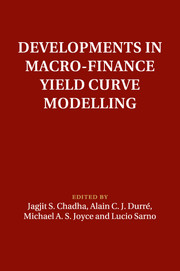Book contents
- Frontmatter
- Contents
- List of figures
- List of tables
- List of contributors
- Foreword
- Preface
- 1 Editors' introductory chapter and overview
- Part I Keynote addresses
- Part II New techniques
- 6 Compound autoregressive processes and defaultable bond pricing
- 7 Yield curve dimensionality when short rates are near the zero lower bound
- 8 The intelligible factor model: international comparison and stylized facts
- 9 Estimating the policy rule from money market rates when target rate changes are lumpy
- 10 Developing a practical yield curve model: an odyssey
- Part III Policy
- Part IV Estimating inflation risk
- Part V Default risk
- Index
6 - Compound autoregressive processes and defaultable bond pricing
from Part II - New techniques
Published online by Cambridge University Press: 05 February 2014
- Frontmatter
- Contents
- List of figures
- List of tables
- List of contributors
- Foreword
- Preface
- 1 Editors' introductory chapter and overview
- Part I Keynote addresses
- Part II New techniques
- 6 Compound autoregressive processes and defaultable bond pricing
- 7 Yield curve dimensionality when short rates are near the zero lower bound
- 8 The intelligible factor model: international comparison and stylized facts
- 9 Estimating the policy rule from money market rates when target rate changes are lumpy
- 10 Developing a practical yield curve model: an odyssey
- Part III Policy
- Part IV Estimating inflation risk
- Part V Default risk
- Index
Summary
6.1 Introduction
Various yield spreads have attracted a lot of attention since the onset of the current financial crisis. For instance, (a) the spreads between interbank unsecured rates and the overnight index swaps – the so-called LIBOR-OIS spreads – gauging market concerns regarding banks’ solvency and liquidity, (b) the spreads between corporate bonds and their Treasuries counterparts and, more recently, (c) sovereign spreads can all be seen as thermometers for the intensity of the crisis developments. These spreads reflect market-participants' assessment of the risks ahead and therefore contain information that is key for both policymakers and investors. In particular, meaningful information is embedded in the term-structure of those spreads and in its dynamics. In order to optimally extract this information, one has to rely on term-structure models. In several respect, the ongoing financial crisis has highlighted the limits of many dynamic term-structure models, notably those that are not able to accommodate non-linearities, stochastic volatilities or switching regimes.
The aim of the present chapter is to propose a general and tractable strategy to model the dynamics of the term structure of defaultable-bond yields. To achieve this, we rely on the properties of compound autoregressive (Car) processes. The usefulness of these processes in the building of risk-free (non-defaultable) bond pricing models is now well documented (see Darolles, Gouriéroux and Jasiak, 2006, Gouriéroux and Monfort, 2007, Monfort and Pegoraro, 2007 or Le, Singleton and Da, 2011).
- Type
- Chapter
- Information
- Developments in Macro-Finance Yield Curve Modelling , pp. 141 - 168Publisher: Cambridge University PressPrint publication year: 2014
- 1
- Cited by



